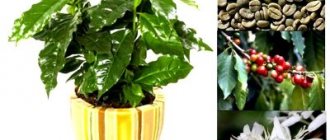I'll tell you a little trade secret. When I place an order for our store, Maragogype coffee comes first. It is always required two to three times more than other items. It would seem, what is worse than the luxurious “Ethiopia Sidamo Mocha” or the exquisite “Kenya”, the brutal “Cuba”? It happened that the situation was stalemate: the cargo had not yet been delivered by the transport company, and the maragojeep was already all reserved (consider it sold). It was ordered in advance, and after submitting an application to the supplier, they eagerly await its arrival. But the price for this variety is much higher than other well-bought ones.
The secret of popularity is not only in large, beautiful grains and a magical aroma. Maragojipe has a unique aura! It is ensured by the originality of its origin, the philosophical depth of taste and the mystery hidden inside its voluminous fruits. There is something to talk about: maragogyp coffee, is it an accident or a gift of nature?
Origin of Maragogype coffee
Harvesting coffee berries in Brazil
The origin of the variety is associated with the beginning of the emergence of coffee plantations in Brazil. In those days, coffee trees were planted randomly, without systematic distribution by variety. The goal was to identify varieties for which the Brazilian climate would be most favorable. The trees grew, and with the help of wind and insects, pollen was transferred from one tree to another - cross-pollination occurred. Thus, in 1876, a tree with large leaves and fruits was discovered, the size of which had not previously been found in any known variety of coffee. The resulting variety of Arabica was named Maragodjip - in honor of the city that was located next to the plantation.
The first plantations of the Maragodzhip variety were planted next to tobacco ones. This proximity significantly influenced the aroma of the beans - the taste of the finished drink gives off notes of tobacco.
History of the variety
The history of Maragogyp coffee is very interesting. Coffee trees did not grow in Brazil until the Portuguese brought them there. Many different varieties were planted, but not all of them took root. Some trees remained, were pollinated, and as a result a new type of coffee with unusually large beans grew. It was discovered near the city of Maragodzhip. According to one version, the plant arose as a result of a mutation of Arabica Tinika, according to another, it is the result of cross-pollination of Arabica and Liberica. The second version is supported by the intense aroma inherent in Liberica.
Features of the chemical composition, taste and aroma of grains
Maragogipe is a classic Arabica, but the size and structure of the beans have a decisive influence on the chemical composition, aroma and taste of coffee. The caffeine content in Maragogip beans is lower than that of other Arabica varieties, amounting to 0.5-0.8% of the composition. This results in a softer, more balanced taste.
Coffee beans contain less caffeine than other Arabica beans, resulting in a milder taste.
Coffee beans contain about 18% essential oils. When frying, oils form an invisible film on the surface, which gives the taste and aroma characteristic of the variety. The place of growth has a direct influence on the aroma. Since the structure of Maragogype coffee beans is porous, they absorb odors with increased intensity. The finished drink takes on berry, fruit, chocolate, nut or tobacco shades.
The grains contain about 8% sugar. When roasted, the sugars give the fruit a deep, dark, uniform hue. In addition to the color, sugar softens the tart taste of coffee.
| Nutritional value of coffee (based on 10 grams of ground coffee per 100 ml of water) | |
| Squirrels, gr. | 0,2 |
| Fats, gr. | 0 |
| Carbohydrates, gr. | 0,3 |
| Potassium, gr. | 0,04 |
| Calories | 3 Kcal |
Why does the taste differ?
After trying the drink for the first time, don’t rush to conclusions. It is impossible to just unequivocally express your opinion about Maragogipe Nicaragua coffee. Each person can find something unusual in his taste that another has not noticed. According to reviews, for some the entire floral bouquet is revealed, for others only creamy notes are heard, and the rest fades into the background. Of course, all this depends on storage conditions, on the coarseness of the grind, on the correct technology and degree of roasting, on the brewing method - someone needs to hurry, and he will simply pour hot water over the finely ground beans, while others will allow themselves only brewed coffee in Turk. Although boiling in a Turk is the recommended preparation method for this drink.
Taste characteristics of this variety when grown on various plantations
Today, the variety is rarely grown due to low yields.
Currently, Maragogipe coffee plantations practically do not exist in Brazil. This is due to the plant’s demands on external conditions (temperature, soil, humidity, lighting) and low yield. The annual yield per tree is almost 2.5 times lower than that of other Arabica varieties. Small plantations of Maragojipe can be found in Mexico, Guatemala, Colombia, Nicaragua and Hawaii.
Nicaragua
This Maragogipe comes from the Jinotega and Matagalpa regions with altitudes of 1000-1200 meters above sea level in Nicaragua.
The largest Maragogipe grains are found in Nicaragua. They have a tart, thick, balanced taste with notes of wine. The sourness is less pronounced compared to the fruits of this variety grown on other plantations. The aroma of the finished drink is rich and noble. The taste of the drink is strong, thick, with floral or fruity undertones. The aftertaste is pronounced and gently reeks of chocolate. The higher above sea level the coffee plantations are, the lower the caffeine content. Maragojipe in Nicaragua grows at an altitude of 1400-1700 meters above sea level. Therefore, this drink does not cause heart palpitations. Ideal for a morning boost of energy.
Guatemala
Maragogipe, grown in Guatemala, is considered the best in Central America. This determines its origin - originally a Brazilian variety, and growing conditions close to ideal. There are three active volcanoes nearby, the ashes of which saturate the substrate for growing coffee with useful minerals. Guatemalan Maragogipe has a rich, bright taste with woody undertones. The sourness is pronounced. The aroma has a hint of smoke. The aftertaste is pleasant, with notes of black currant. The finished drink is tart, rich, and rich. With hints of fruit, flowers and smoke.
Mexico
A variety with a slight sourness, a more pronounced taste of chocolate and nuts.
It is believed that the best variety, Maragogipe, grows in the south of Mexico. The taste of coffee from Mexico has the mildest, balanced taste. The sourness is weakly expressed. The aftertaste is soft, with hints of chocolate and nuts. The aroma is powerful, rich, bright. The caffeine content is naturally low. Therefore, Mexican Maragogip can be drunk in the evening.
Colombia
Intense flavor with apricot notes.
In Colombia, Maragogipe is the main variety to grow. Coffee has the most complete, rich taste. The taste is tart, slightly bitter, with fruity notes of apricot. The aroma is rich, pronounced, there are notes of baked milk. The aftertaste is soft, gives off cocoa. The drink is perfect for starting the day; it has pronounced invigorating properties. It should be cooked exclusively in a Turkish oven.
Hawaii
Rarely found on sale, it has a honey-citrus taste.
The rarest variety of the variety is the Hawaiian Maragodzhip.
It is especially appreciated by coffee connoisseurs and lovers for its light honey-citrus flavor and chocolate aftertaste.
What buyers say
Many people who drink this type of coffee share their tips for grinding their coffee beans. They believe that it is better to grind such coffee to a medium grain size, because coarse grinding produces sourness. For those who like to make coffee with milk, don't worry that the flavor won't fully develop because of the milk, that's not true. The combination of these ingredients will remove the sourness and make it simply excellent. Everyone who tried Maragodzhip was satisfied and left only positive reviews about it.
Benefit
Does not harm people with heart disease due to low caffeine content
Coffee beans are high in nutrients. Regular consumption of this natural drink will protect you from the development of various diseases. For example, the likelihood of diabetes will decrease by 50% in men and by 30% in women if you drink 6 cups of coffee a day. Caffeine reduces the risk of developing Parkinson's disease. This is due to the fact that it inhibits signals in the nerve endings through which information is transmitted that triggers the disease.
The Maragogyp variety has a low caffeine content, for this reason it can be consumed by people prone to increased heart rate.
Grains grown on plantations located on volcanic rocks will fully replenish the body with minerals and vitamins.
Harm
Drinking coffee is associated with a high level of tonic properties. However, there is also a downside to positive influence. Yes, after using it you feel a significant surge of strength, however, after a few hours there is a decline. Coffee uses up the body's own reserves without bringing in energy from outside. Addictive. Under the influence of caffeine, the body's digestive system is in a state of stress and digestion is impaired.
The consumption rate for pregnant women should be reduced as much as possible.
The daily intake of coffee is 2 cups of 200 ml, for pregnant women it should be halved.
Drinking is contraindicated:
- with high blood pressure;
- for glaucoma;
- with renal failure;
- for coronary heart disease and atherosclerosis;
- children;
- in old age.
It is not recommended for children and elderly people to drink.
As mentioned above, the structure of the grains of the Maragodzhip variety is loose and absorbs substances contained in the environment. Therefore, you should be careful when choosing grains to avoid purchasing a product grown in unfavorable conditions.
Reviews
Many coffee lovers who have tasted the drink leave mostly positive reviews.
Anna, Kostroma: I liked the unobtrusive aftertaste with wine or chocolate-nut notes, a pleasant sourness, which you can get rid of if you buy medium-ground beans.
Igor, Moscow: The variety is unlike other Arabica varieties. It has a fruity and floral aroma, giving you a feeling of vigor and energy.
Lisa, Tver: I liked it in combination with milk, and there was no loss of original properties. The coffee is worth trying, despite the high price.
Average cost and best brands
It is possible to feel and enjoy the real taste of Maragogip coffee only when purchasing a quality product from a responsible manufacturer. The average cost of 250 grams of coffee beans is quite high, starting from 600 rubles. This is due to the fact that the capricious variety requires increased growing conditions, while its productivity is low compared to others. Producers are abandoning it in favor of other Arabica varieties. Against this background, Maragodzhip becomes rare, and its price rises.
Due to difficulties with cultivation, prices for Maragogype are quite high
The most convenient ways to purchase your favorite drink are online stores and specialized coffee shops. When choosing coffee, give preference to the following brands:
- Malongo;
- Blues;
- The royal courtyard.
Cooking methods
The taste of the drink largely depends on the specifics of brewing. To truly enjoy it, it is recommended to purchase coffee beans. Then decide what you will use for brewing - a Turk or a coffee machine.
You can also “arm yourself” with a French press or a geyser coffee maker.
French press
In Nicaragua, maragojipe is always prepared using this device. A French press is recommended for making strong coffee. It simplifies the cooking process.
It is enough to pour ground fruits into it, pour hot water over them and lower the piston. The final stage is pouring the drink into cups.
Geyser coffee maker
Making coffee using such a device is not as efficient as using a Turk or French press. The reason is the loss of aromatic qualities by the grains during cooking.
It is recommended to use a geyser coffee maker for people who prefer a concentrated and bitter drink.
Turk
This cooking method is considered classic. Coffee powder along with granulated sugar is poured into a container and filled with water. As the temperature increases, the mass thickens.
Thanks to the Turk, it is possible to preserve the maximum aromatic and taste characteristics of the grains. After the water boils, it is removed from the heat. Its contents are poured into cups.
Coffee machine
This method of preparing the drink is as simple as possible. Using this device, you can quickly “transport” the taste of maragogypa beans directly into your cup.
The coffee machine will make espresso, Americano, latte, shocachino - whatever you choose.
Maragojipa fruits are unique. If you become their lucky owner, we advise you to stock up on a Turkish coffee, as with its help you will be able to create exquisite and unforgettable coffee.
Bean storage options
It is preferable to store in glass or ceramic containers with a tight lid.
The processing of the grains has a direct impact on the shelf life. Fresh green grains can be stored for a year - they will not change their properties. Roasted grains are less stable, they are able to absorb foreign odors and moisture from the air, so their shelf life in a paper bag is no more than two weeks. Foil packaging will preserve coffee for three months, and in a tightly closed glass or ceramic container the beans can be stored for six months.











